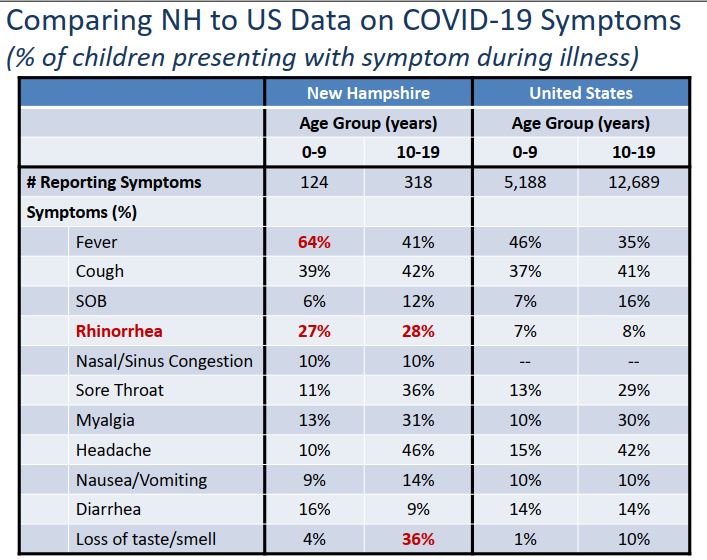In a recent analysis of USA children presenting COVID-19 symptoms, fever remains a predominant symptom, particularly for New Hampshire children under ten years old. There are some notable difference between age groups 0-9 and 10-19, as well as between NH and the the nation.
One challenge with a COVID-19 response is that the list of associated symptoms seems to often change. Not only have notable symptoms or comorbidities changed over time, but there are also differences based on location and age.
New Hampshire’s online COVID-19 resources include guidance for schools, and therein presentations from weekly educational institution calls. In the Oct. 7, 2020 presentation, we find a stunning comparison of SARS-CoV-2 symptoms present in school aged children in New Hampshire vs. the United States.
Fever was considered one of the predominant symptoms of a SARS-CoV-2 infection. We came to learn that children with this infection were often asymptomatic and poor transmitters. Recently, there were some articles asserting a lesser association to fever as a symptom.
However, for youth in NH, we see 64% of those under 10 years of age with this infection have fever as a symptom, a rate far exceeding cough and rhinorrhea (runny nose). It is interesting to note fever symptoms drop to 41% for ages 10-19, sharing a top tier of symptoms with cough, sore throat, headache, and loss of taste/smell. Also interesting is how this differs with the US aggregate data. Nationwide, for children under 10 yrs of age, temperature is still the most prevalent symptom, but at 46%.

The report breaks out the NH symptoms more specifically. I am uncertain if “All Ages Combined” means 0-19 or ages beyond that, given it asserts cough at 56% overall yet in the four groups listed it ranges between 32% and 45%.

Personally, this recent state-specific data confirms my previous belief that we should be performing an afternoon temperature check of students at school, to help reduce transmission in the classroom and on the bus home. Consider that symptomatic children developing symptoms in late afternoon, evening, or early morning should be held home by parents: the remaining quarter of newly symptomatic children will develop these symptoms at school. For Pre-K through grade 8, fever is the most common symptom. Let’s ensure our schools are looking for it.
You can see the entire October 7 presentation here: Weekly Educational Institution Calls, October 7, 2020